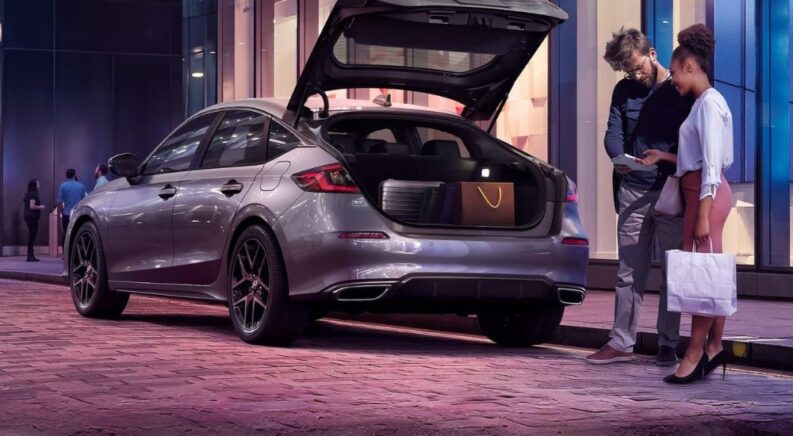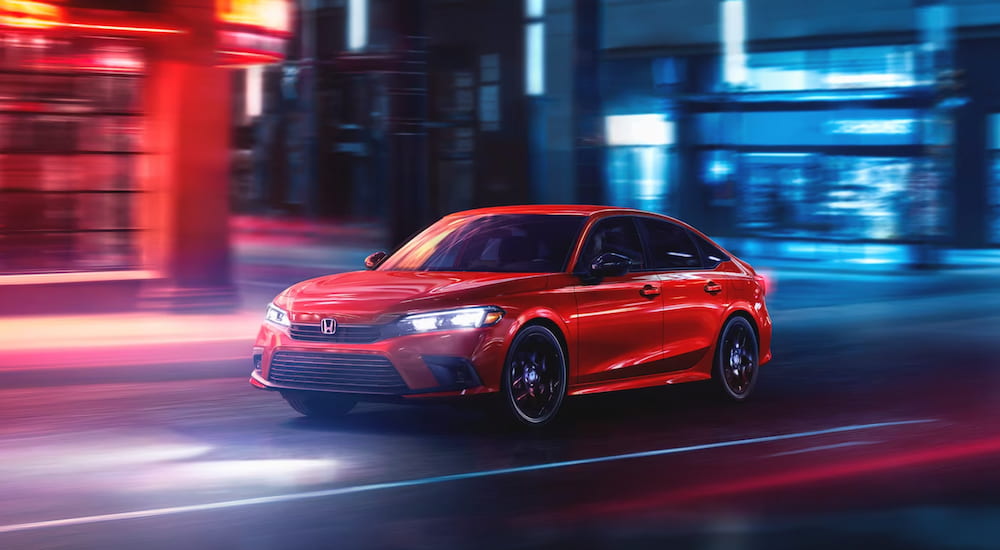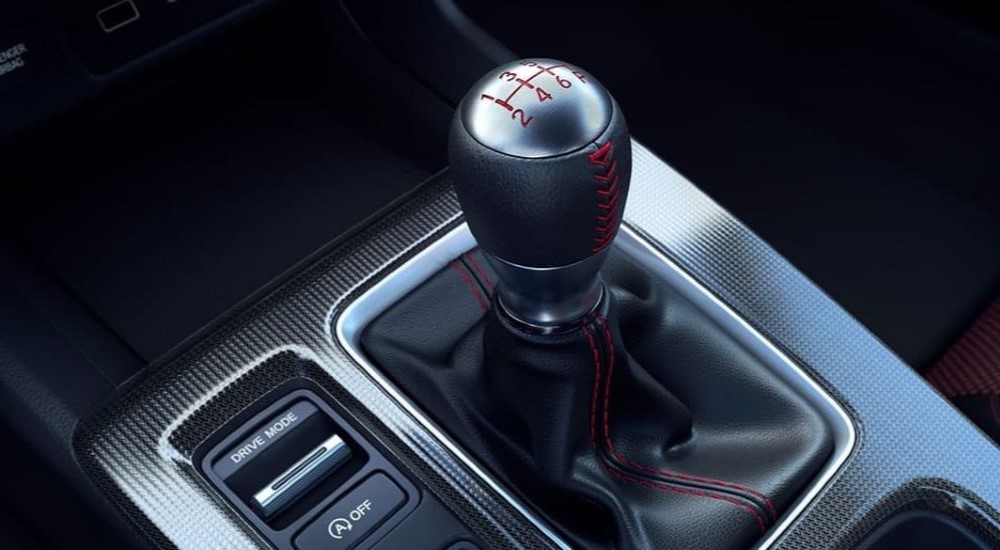For decades, manual transmissions in American vehicles have been an endangered species. According to Motor1, less than 2% of cars sold stateside in 2023 were equipped with manual transmissions. Yet despite the proliferation of automatic transmissions, stick shifting has carved a niche with automakers like Honda still offering it in certain vehicles. Honda even trumpets itself as “America’s #1 brand in manual transmission sales.”
Unfortunately, one more Honda manual option is going the way of the dodo bird. News broke recently that the 2025 Honda Civic Hatchback is losing its manual transmission option as part of its mid-cycle update. This is an even bigger deal than you might think—while performance Honda models like the Civic Type R and Civic Si still proudly come with manual transmissions, the Civic Hatchback was the last mainstream Honda to do so. Now, if you’re looking for a new Honda Civic Hatchback for sale (or any other non-performance Honda, for that matter), it’s automatic or nothing.
It’s certainly a sad day for fans of manual transmissions—and those aren’t just limited to grumpy old “get off my lawn” types. The first three vehicles I owned were stick shifts, which included a Honda Civic, so I certainly understand the feeling. I wanted to look at how we got to this point, at least in North America, and what the future holds for manual transmissions in Honda vehicles.
Why Do So Many American Cars Have Automatic Transmissions?
As I talked about at the beginning, automatic transmissions are practically ubiquitous in American cars. But interestingly, not every country has gone to the extremes of the United States in automatic transmission sales. While manual transmission sales for the first half of 2023 were around 2% in Japan and Oceania and 4% in China, they represented 42% of vehicle sales in South Africa, 36% in Latin America, and 32% in Europe.
So why has the automatic transmission taken such a firm hold in America? There are a couple of reasons for this. One is that it is much easier to drive, making it much more convenient. Considering the most recent AAA American Driving Survey found drivers average more than an hour a day behind the wheel—and that more than 80% of American drivers multitask while driving, such as eating or reading emails—you can understand why people would gravitate towards the driving method requiring less effort.
Another reason is that the roadways are different. In general, American roads are smoother and wider, making driving more straightforward. Shifting is largely limited to stop-and-go city driving, where constantly changing gears is an annoyance. Conversely, the narrow and winding roads of Europe require a more reactive approach, and the ability to grab whatever gear you want is more beneficial. Finally, at this point, it’s almost become self-sustaining in that there are far more options for cars with automatic transmissions. Even the biggest manual transmission supporter may feel forced to buy a car with an automatic if it’s the only vehicle that has the other features they want.
Phasing Out the Manual Transmission in Hondas
Put it together, and you can see why even the #1 manual transmission automaker would start putting this technology out to pasture with certain vehicles. The Honda CR-V compact crossover was one of the first, losing its manual transmission after 2006. The Honda HR-V subcompact crossover ditched the manual transmission for 2019, and the Honda Accord followed after the 2020 model year (in a further insult to injury, no one even noticed Honda had stopped making manual Accords until about seven months after the fact). Vehicles like the Honda Pilot midsize crossover, Honda Ridgeline pickup, and Honda Odyssey minivan never had a manual transmission in the first place.
The Honda Civic Sedan lost its manual transmission option in the same year as the Accord. However, even after the introduction of the eleventh-generation Civic in 2022, Honda held out on the Civic Hatchback for a few more years. The continuously variable transmission (CVT) Honda is known for was the default transmission—and arguably the smoother, more fuel-efficient design—but enthusiasts could still opt for a six-speed manual. At least, they could until the 2025 model year arrived.
Why Is the Civic Hatchback Losing the Stick Shift Option?
That leads to the question of why Honda chose now to make the Civic Hatchback automatic-only. It appears the primary reason is that the Civic Sedan and Civic Hatchback are now both being offered with a hybrid powertrain, a form of propulsion that almost exclusively uses automatic transmissions. The reason is that there are numerous forms of power at work—the internal combustion engine, the electric motor, the regenerative brakes, etc—which require a more complex gearbox to make the most of.
Honda experimented with manual hybrids in the past with the Honda Insight and Honda CR-Z. Those had two things going for manual fans, though. One was that they used a simpler hybrid design where the engine and the motors worked at the same time, which made adding a manual transmission easier. Modern Honda hybrids, on the other hand, rely far more heavily on their electric motors, making the requirements of a manual transmission much more complex.
Second is the continuing downward direction of manual transmission sales in the United States. Although Honda hasn’t released the exact numbers for the Civic Hatchback, I can’t imagine the manual transmission amounting to a significant percentage of Civic sales, never mind overall Honda sales. With the numbers likely to shrink further with the introduction of the Civic Hatchback Hybrid, what most likely happened is that Honda decided it wasn’t worth either A) continuing to produce the existing manual Civic Hatchbacks for the amount they were selling or B) trying to develop a manual transmission that can work with modern hybrid technology.
Keep in mind that Honda has not made an official statement on why it axed the manual transmission in the Civic Hatchback. It didn’t even deem the news worth mentioning when it officially announced the 2025 Honda Civic. I’m simply giving you my read on the situation based on what I know about the technology, recent trends, and automotive economics.
What Do Manual Transmission Aficionados Have Left?
Although the logic for ending the Civic Hatchback manual transmission is understandable in a vacuum, it’s still a heartbreaker for loyalists. At this point, performance vehicles are the only way to get a new stick-shift Honda. For hatchback fans, this means the Honda Civic Type R, which uses a more advanced version of the Civic Hatchback six-speed to match its 315 hp turbocharged engine. The closest you can get to an everyday Honda with a manual is the 200 hp Honda Civic Si sedan.
If you want a true non-performance Honda that includes a stick shift, your only option will soon be the pre-owned route. Fortunately, there are still plenty of high-quality used Civics on the market, and with Hondas known to last 200,000 miles or more, you’ll likely get many more years of use from your manual transmission machine.
There is one little secret some people don’t know: many Honda vehicles, including the Civic, have available paddle shifters on the steering wheel that let you shift the CVT like a manual. Obviously, it’s not the same as pushing in the clutch and grasping the shift knob, but it does give you some control over your engine RPMs and torque when you want it. In the meantime, manual transmission enthusiasts like me will have to hope that at least the Civic Si and Civic Type R carry the flag for a while longer.






